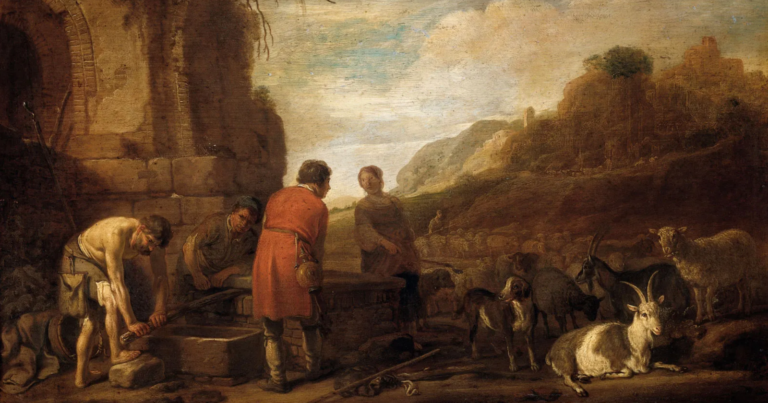“Jesus replied: ‘Love the Lord your God with all your heart and with all your soul and with all your mind.’ This is the first and greatest commandment. And the second is like it: ‘Love your neighbor as yourself.'”
Matthew 22:37-40
The Gospel of Matthew opens the New Testament with profound lessons for daily Christian living.
It presents Jesus Christ’s life, teachings, and the fulfillment of Old Testament prophecies, serving as a bridge for believers seeking guidance. In his gospel, you’ll find themes of faith, righteousness, and discipleship tailored for modern application.
In this article, we’ll interpret Matthew’s narrative and explore key teachings that resonate with our aspirations and challenges.
Prepare to uncover how this Gospel can influence your everyday decisions and interactions, truly unlocking everyday wisdom.
Exploring Matthew’s gospel
The Gospel according to Matthew is the opening book of the New Testament of the Bible, and the first of the Four Gospels, Matthew, Mark, Luke, and John.
Traditionally, the Gospel of Matthew is attributed to Matthew the Apostle, a tax collector turned disciple of Jesus.
This assertion stems from the early Christian community, with Papias of Hierapolis (circa 125 AD) being one of the first to mention Matthew as the author.
However, modern scholarship tends to view the work as anonymous, written by a Jewish Christian with a thorough knowledge of Hebrew scriptures.
The text, composed in Greek, exhibits an intimate familiarity with Jewish customs and law, suggesting the author’s intent to connect with a Jewish-Christian audience.
Historical background
The Gospel of Matthew was likely written between 80 and 90 AD, a period marked by the aftermath of the Roman destruction of Jerusalem and the Second Temple in 70 AD.
This catastrophic event, which reshaped Jewish society, is reflected in the gospel’s themes of conflict and community identity.
Matthew’s narrative addresses a community grappling with its Jewish heritage while navigating the emergence of a distinct Christian identity.
The gospel’s frequent references to Jesus as the fulfillment of Hebrew prophecies aim to bridge the gap between Jewish tradition and Christian belief, presenting Jesus as the long-awaited Messiah.
The setting of Matthew’s Gospel, while not explicitly detailed, resonates with the issues facing the Jewish diaspora and early Christians in the late first century.
This includes tensions between adherents to traditional Judaism and those who embraced Jesus as the Messiah.
Key teachings like the Sermon on the Mount, the Beatitudes, and the Lord’s Prayer underscore its spiritual depth and commitment to presenting Jesus as the Savior for all.
How is Matthew structured?
The Gospel of Matthew presents a meticulously organized composition that intertwines Jesus’ life and teachings with Jewish tradition, aiming to establish Him as the Messiah.
Here’s an overview of its structure:
- Prologue: Genealogy, Nativity, and Infancy (Matthew 1–2)The gospel opens with Jesus’ genealogy from Abraham and King David, setting the stage for the narrative of his miraculous birth and early life events. Notably, it includes five women, highlighting the divine intervention in Jesus’ birth.
- The Five Main SectionsMatthew is structured around five key speeches of Jesus, mirroring the Pentateuch’s structure, underscoring His role as a teacher and prophet:
- The Sermon on the Mount (including the Beatitudes, and lays out the principles of the Kingdom of Heaven, Chapters 5-7)
- The Missionary Discourse (Chapter 10)
- The Parables of the Kingdom (Chapter 13)
- Teachings on the Church (Chapter 18)
- The Olivet Discourse on End Times (Chapters 24-25)
- Climax and Conclusion: The Passion, Resurrection, and Great Commission (Matthew 26–28)The narrative culminates in Jesus’ crucifixion and resurrection, ending with the Great Commission to spread the gospel to all nations.
Matthew also includes unique elements not found in the other Gospels, such as the explicit mention of the church (ekklesia), a focus on Jesus as “Son of David,” and several parables and teachings exclusive to this account.
The Genealogy and birth of Jesus
Let’s take a closer look at the beginning of Matthew’s Gospel, which sets a profound foundation for the story of Jesus.
Right from the start, Matthew grabs our attention with a detailed genealogy, tracing Jesus’ lineage back to Abraham and King David.
Ever wonder why?
Well, Matthew is making a bold statement here: Jesus is the promised Messiah, deeply rooted in Jewish tradition.
By linking Jesus to Abraham and David, Matthew is not just recounting history — he’s highlighting a divine plan unfolding through generations.
It’s like discovering you’re part of a legacy that stretches back centuries, giving you a sense of identity and purpose.
Now, let’s talk about the birth of Jesus.
Matthew doesn’t just tell us Jesus was born — he sets the scene with prophecies and dreams, making it clear that Jesus’ birth was anything but ordinary.
The mention of five women in the genealogy—Tamar, Rahab, Ruth, Bathsheba, and Mary—breaks the norm, showcasing God’s grace and the pivotal role of women in Jesus’ lineage.
The genealogy regularly notes the male who fathers a child, but Matthew delivers an exact statement when he reaches Joseph:
“The husband of Mary, of whom Jesus was born” (1:16).
The relative pronoun “of whom” in Greek is ῆς, which clearly refers to Mary, for it is specific to the feminine gender.
And the passive voice of the verb ἐγεννήθη – “was born” – is the only passive among the forty occurrences of γεννάω in the genealogy, which prepares the way for the divine conception and natural birth of Jesus Christ in 2:1.
What makes Matthew’s Gospel stand out?
The Gospels of Matthew, Mark, and Luke are known as the Synoptic Gospels because they share a similar view of Jesus’ life and teachings.
They all include parables, which are short stories that teach a moral or spiritual lesson. In Matthew, we find ten parables specifically about the Kingdom of Heaven.
Seven of these are grouped together in Chapter 13, showing their importance in his Gospel.
Each of these Gospels is unique and among them, Matthew’s Gospel stands out for several reasons. Let’s explore why:
- The infancy narrative: Only Matthew provides a detailed account of Jesus’ early life, including his genealogy, the visit of the Magi, and the family’s escape to Egypt. This narrative highlights the fulfillment of Old Testament prophecies and Jesus’ miraculous beginnings.
- Emphasis on teachings: Matthew contains the complete Sermon on the Mount, which includes the Beatitudes, the Lord’s Prayer, and many other foundational teachings of Jesus. This sermon is a comprehensive guide for living a life aligned with God’s will.
- Church foundation: Matthew uniquely discusses the establishment of the church and its authority, as seen when Jesus gives Peter the “keys to the kingdom of heaven.” This moment signifies the beginning of church leadership and governance.
- Unique parables: Several parables are exclusive to Matthew, such as the Weeds Among the Wheat and the Parable of the Unforgiving Servant. These stories convey deep spiritual truths and ethical teachings central to the Christian faith.
- The Great Commission: The Gospel ends with the Great Commission, where Jesus instructs his disciples to spread his teachings to all nations. This directive emphasizes the universal message of Christianity and the responsibility of believers to share their faith.
Matthew’s key themes
1) Fulfillment of prophecy
Matthew’s Gospel begins with a genealogy that establishes Jesus as the rightful heir to David’s throne, fulfilling the Old Testament prophecies.
The author repeatedly emphasizes Jesus as the Messiah, citing Hebrew scriptures to show how Jesus’ birth, life, and ministry fulfill divine predictions.
Therefore, this theme underlines the continuity between the Jewish tradition and Christianity, asserting that Jesus is the long-awaited Savior who embodies God’s promises to His people.
Simply put, Matthew’s depiction of Jesus’ healing ministry invites readers to recognize in Jesus a savior who is deeply moved by human suffering and willing to intervene with saving power.
2) Kingdom of heaven
“Blessed are the poor in spirit, for theirs is the kingdom of heaven”
Matthew 5:3
Matthew also places a strong emphasis on the “kingdom of heaven,” a term that appears frequently throughout the text.
This concept is central to Jesus’ teachings, focusing on the spiritual realm governed by God and promised to those who live according to His will.
What exactly is the kingdom of heaven?
Well, it’s both a present reality and a future promise, emphasizing righteousness, justice, and mercy as its core values.
It’s a realm where God’s will is done perfectly, contrasting with the flawed earthly kingdoms.
Matthew highlights that entrance into this kingdom requires repentance, humility, and righteousness that surpasses legalistic adherence to the law.
3) Judgment and mercy
In Matthew’s Gospel, judgment and mercy intertwine in unexpected ways.
Think about it: while it warns of the consequences of ignoring God’s call, it also showcases God’s boundless mercy.
Through parables like the Sheep and the Goats, Matthew illustrates the gravity of our actions and their impact on our fate.
Yet, it also emphasizes that God’s heart leans towards forgiveness, extending mercy to all who seek Him.
The dual themes of divine judgment against sin and God’s mercy towards repentant sinners run throughout these passages, offering both warning and comfort.
The identity of Jesus Christ in the Gospel of Matthew
Jesus Christ in the Gospel of Matthew is portrayed as the promised Messiah, the fulfillment of Old Testament prophecies.
Matthew introduces Jesus as the Son of David and the Son of Abraham (1:1). As a result, he establishes His royal and covenantal lineage.
He is Emmanuel, “God with us,” a teacher with authority and a healer to the afflicted. His role extends beyond Israel as He calls disciples from all nations, emphasizing His universal mission.
Here’s a brief look at the key attributes of Jesus as outlined in Matthew:
- Foretold Messiah
- Royal Descendant
- Divine Teacher
- Universal Savior
Matthew’s emphasis on Jesus as both King and servant reveals a multifaceted identity, one that invites believers to experience the transformative power of His teachings and the breadth of His love.
Understanding Jesus’ teachings
In the Gospel of Matthew, Jesus imparts his most significant teachings, encapsulated strikingly in the Sermon on the Mount.
This sermon, spanning chapters 5 through 7, lays out the core of Christian ethics and life in the Kingdom of Heaven.
Among them, the Beatitudes, a collection of blessings pronounced by Jesus, commence this profound discourse, offering a radical redefinition of happiness contrary to worldly values.
Furthermore, the Lord’s Prayer is presented as a model for prayer that emphasizes God’s holiness, the coming kingdom, and daily dependence on Him for provision and forgiveness.
Jesus’ teachings also reveal a profound emphasis on compassion, justice, and the inherent value of every individual.
One of the most touching illustrations of this is the quote: “Fear not, therefore; you are of more value than many sparrows” (Matthew 10:31).
This simple yet powerful statement encapsulates the essence of Jesus’ message to His followers.
It reassures us that God’s watchful eye is on all, recognizing the worth of each person, regardless of their societal status or the magnitude of their struggles.
With these teachings, Jesus asserts that true discipleship involves a life transformed from the inside out, shining brightly before others and glorifying God in heaven.
Jesus’ path to crucifixion
The later chapters of Matthew’s Gospel lay out the somber and pivotal events leading up to Jesus’ crucifixion.
The narrative unfolds with the treachery of Judas Iscariot, whose betrayal sets in motion the events of the Passion.
The Last Supper, a poignant moment of fellowship and institution of the Eucharist, transitions quickly into Jesus’ agony in the Garden of Gethsemane.
Here, Jesus confronts the imminent suffering with a plea to His Father, showing his humanity and divinity intertwined in purposeful surrender.
Matthew vividly captures Jesus’ arrest, his trials before the religious and political authorities, and the heart-wrenching denial by Peter, one of his closest followers.
These accounts not only fulfill prophetic scriptures but also showcase human frailty against steadfast divine resolve.
Why is His crucifixion is a pivotal moment?
Because is symbolizes the ultimate sacrifice for humanity’s sins, underscoring themes of redemption and unconditional love.
Despite false accusations and palpable injustice, Jesus remains a figure of dignity and composure, ultimately leading to his sacrificial death on the cross—a death that Christians hold as atoning for humanity’s sins.
Resurrection and hope
The climax of the Gospel according to Matthew is the resurrection of Jesus Christ, an event that alters the course of history and human destiny.
The first day of the week brings a seismic shift as an angel rolls away the stone from Jesus’ tomb—not to let Jesus out, but to reveal He has risen.
Mary Magdalene and the other Mary experience a gamut of emotions, from fear to joy, as they encounter the angel and then Jesus Himself. This moment is pivotal, transforming the despair of death into the triumph of life.
Jesus’ resurrection is central to the Christian faith, signifying victory over death and the promise of eternal life for believers.
What’s more, it validates Jesus’ identity as the Son of God and fulfills his prophecies regarding His own death and resurrection.
This account encourages followers to hold onto hope in seemingly hopeless situations, trusting in the enduring power and presence of Christ.
Final thoughts: Embrace Matthew’s Call
For those drawn to the depth and richness of the Gospel of Matthew, the journey continues beyond mere knowledge.
It beckons a lived experience, an invitation to transform understanding into practice.
As we reach the conclusion of the Gospel of Matthew, we are reminded of Jesus’ final directive to His disciples, known as the Great Commission.
This command not only encapsulates the essence of Matthew’s Gospel but also serves as a timeless call to action for all believers.
You can even consider it an invitation to participate in the continuation of Jesus’ ministry by spreading His teachings and baptizing in the name of the Father, Son, and Holy Spirit.
So, here’s the thing:
For those seeking to deepen their understanding of “The gospel of Matthew,” it’s essential to recognize that this Gospel is not merely a historical account to be studied — it is a living message, demanding a response.
- Strive to follow Jesus’ teachings daily and help others to do the same.
- Serve the least among us, as Jesus taught, by volunteering your time and resources to help those in need.
- Practice forgiveness and mercy, as exemplified by Jesus, even in the face of betrayal and injustice.
- Continuously seek to grow in faith and understanding of the Scriptures, allowing them to shape your life and actions.
Let this Gospel be a guide for how you live out your faith and share it within your community and beyond














